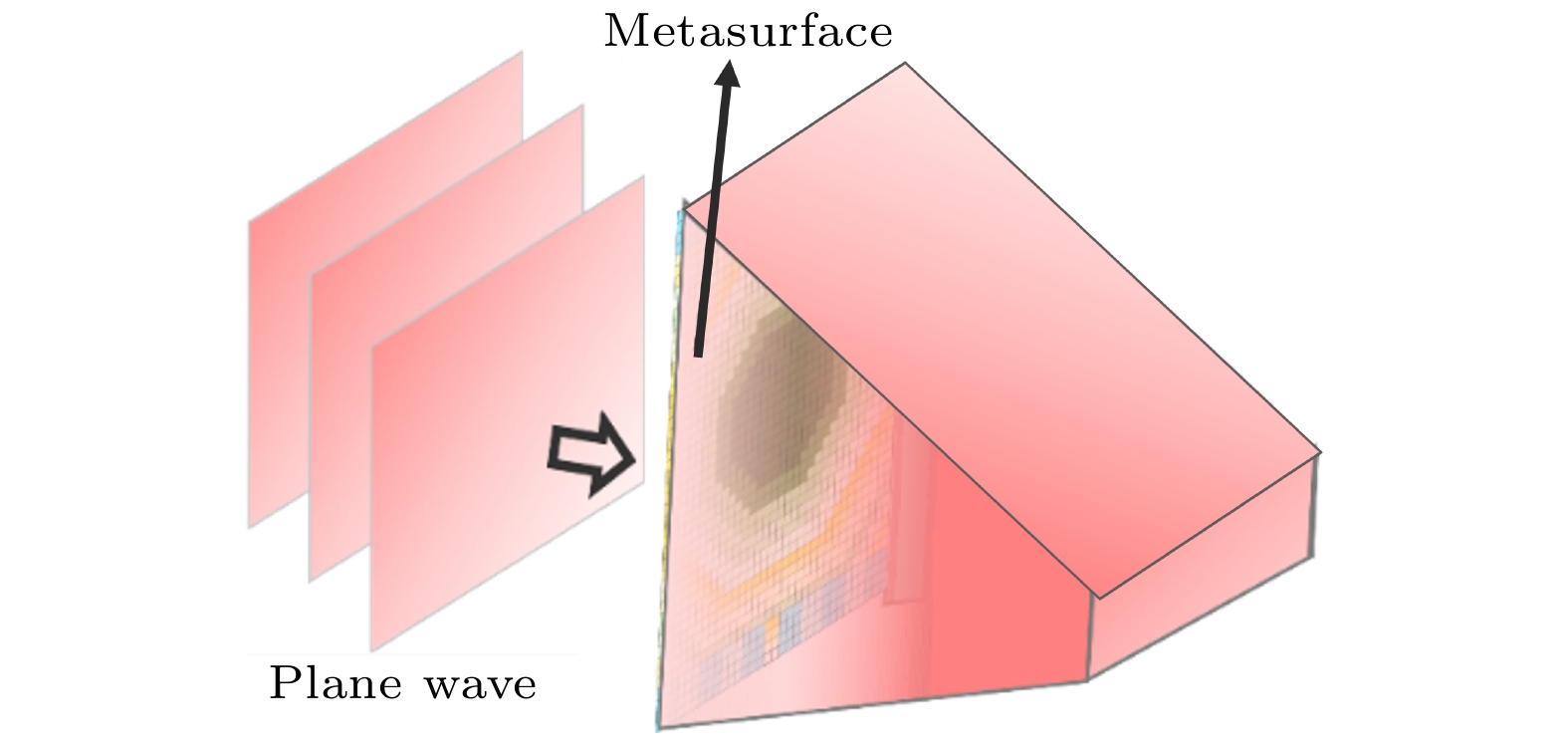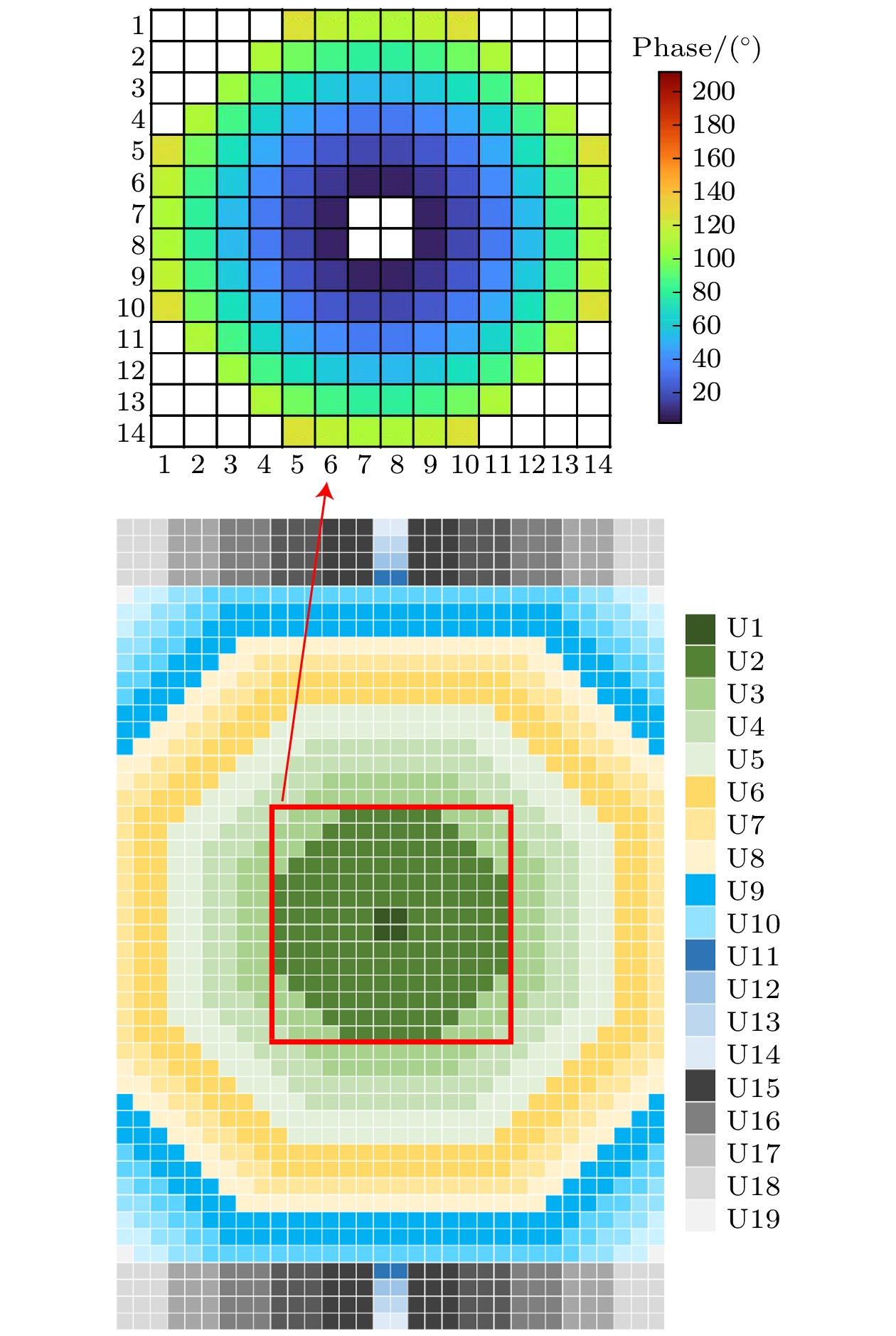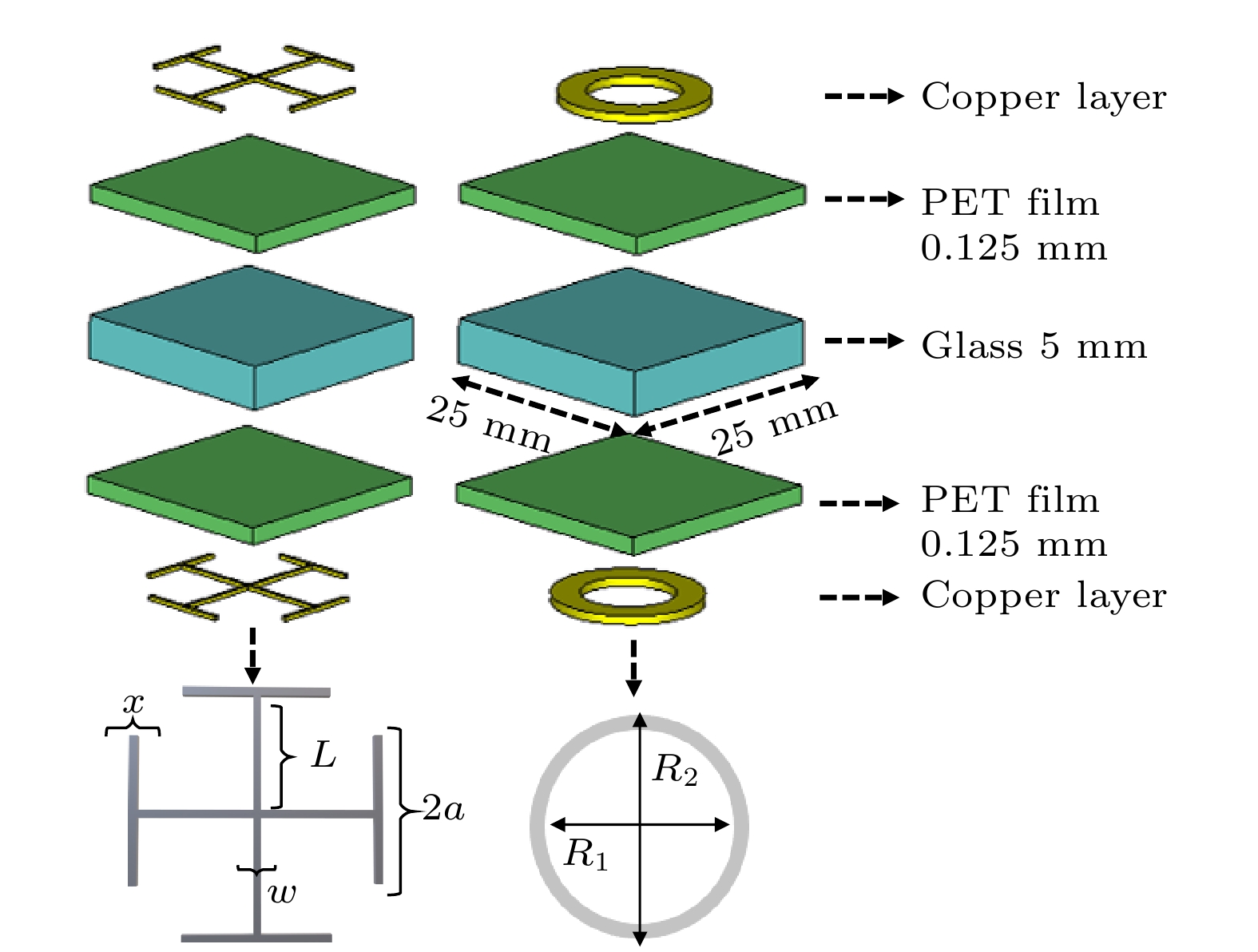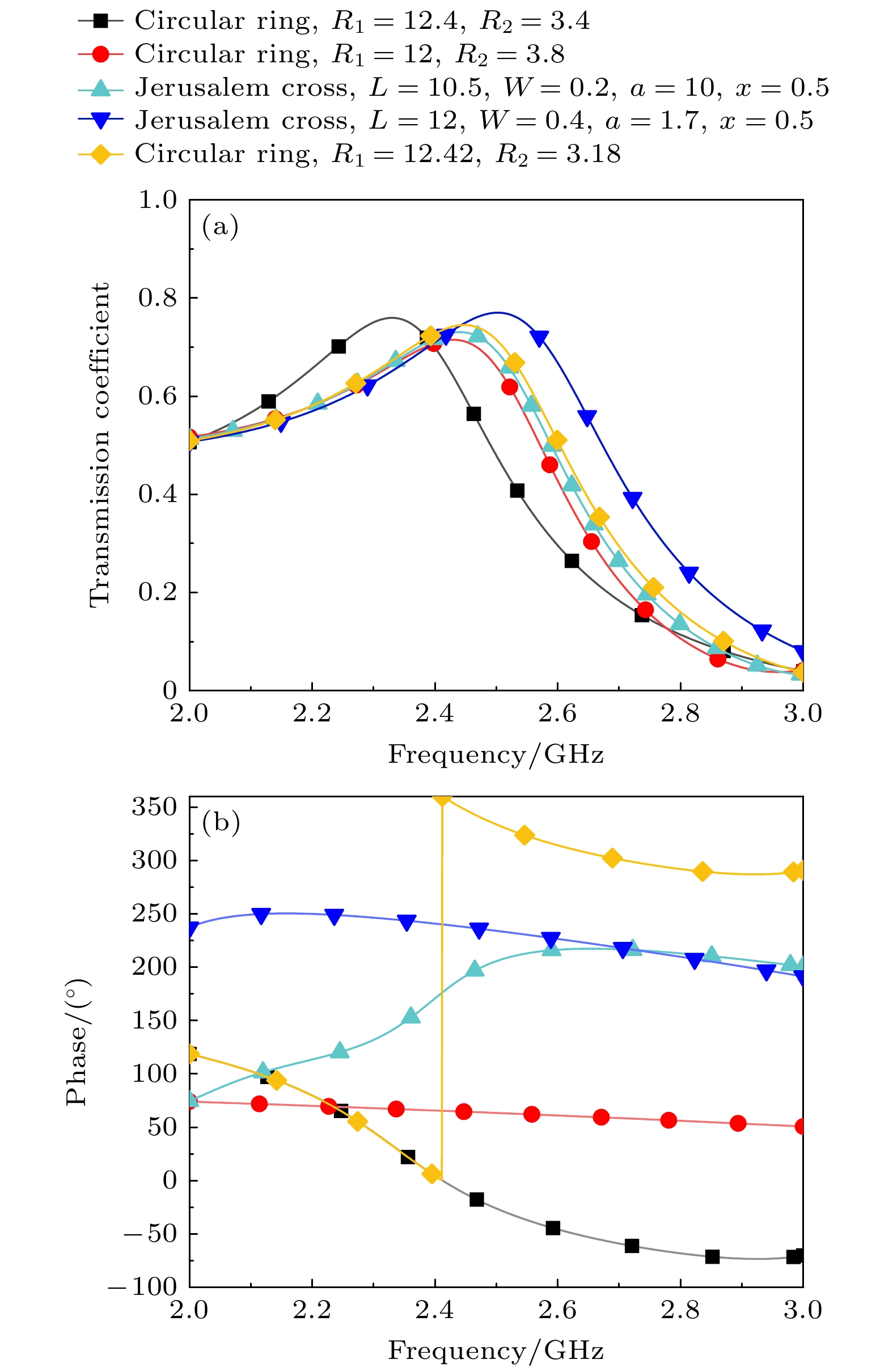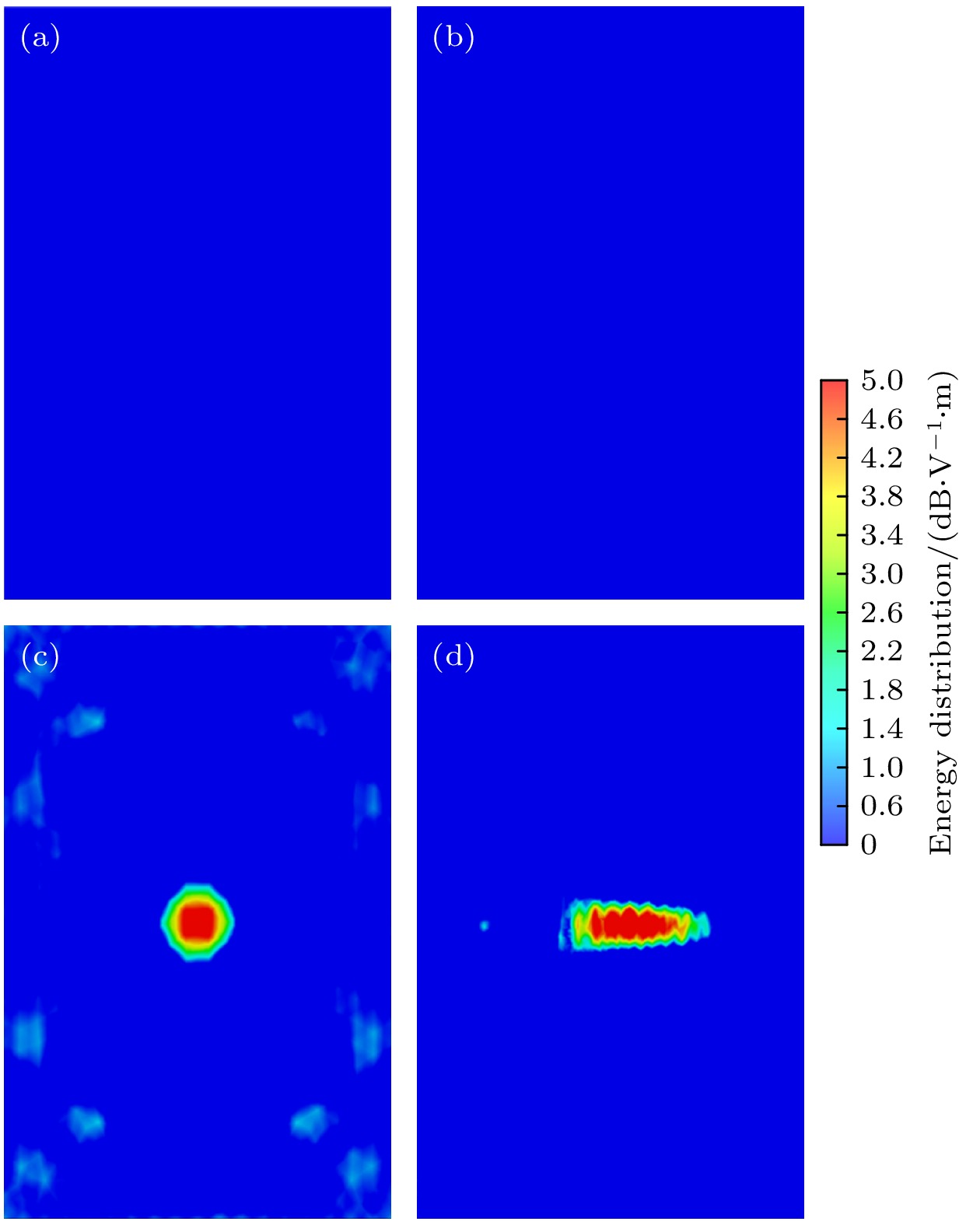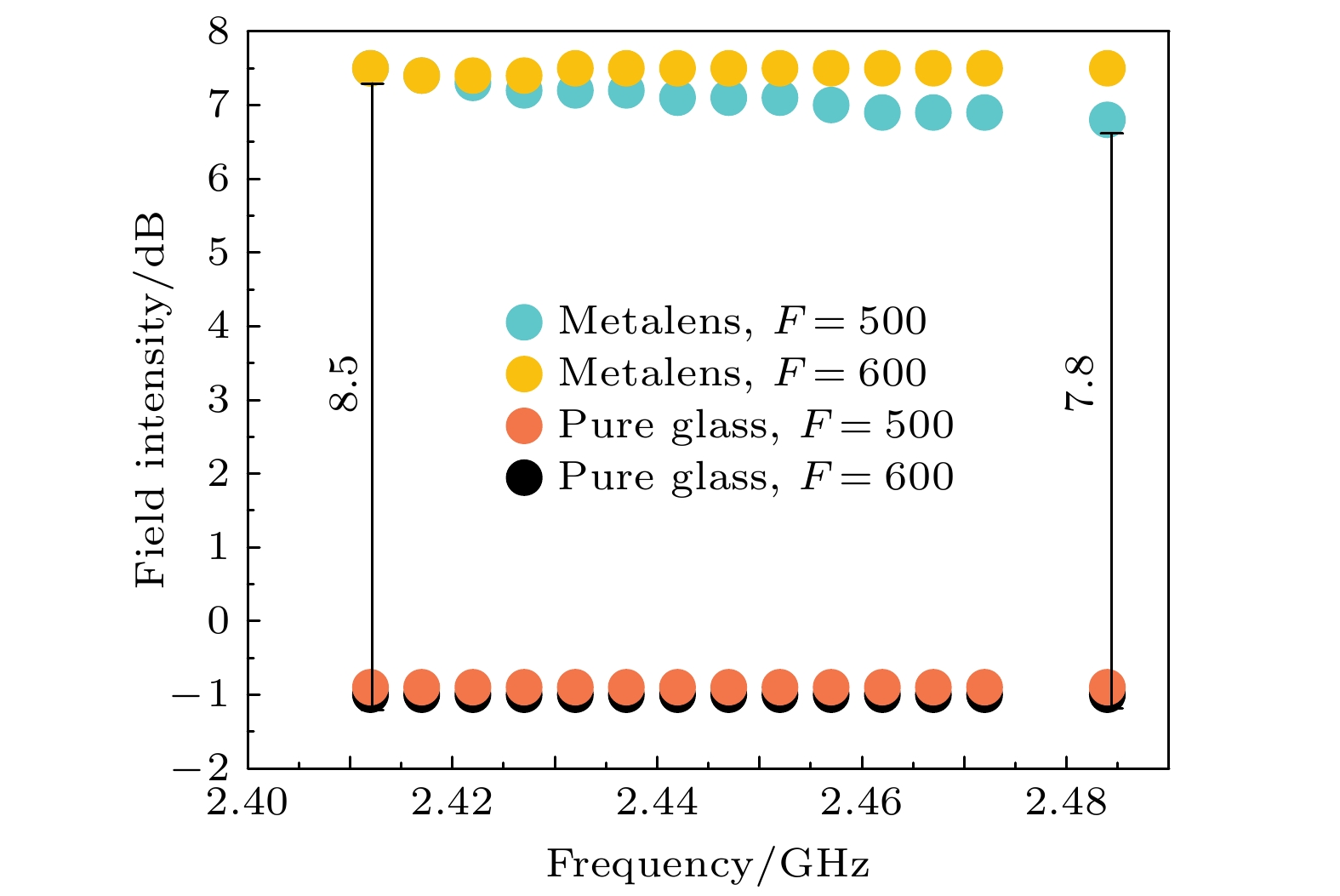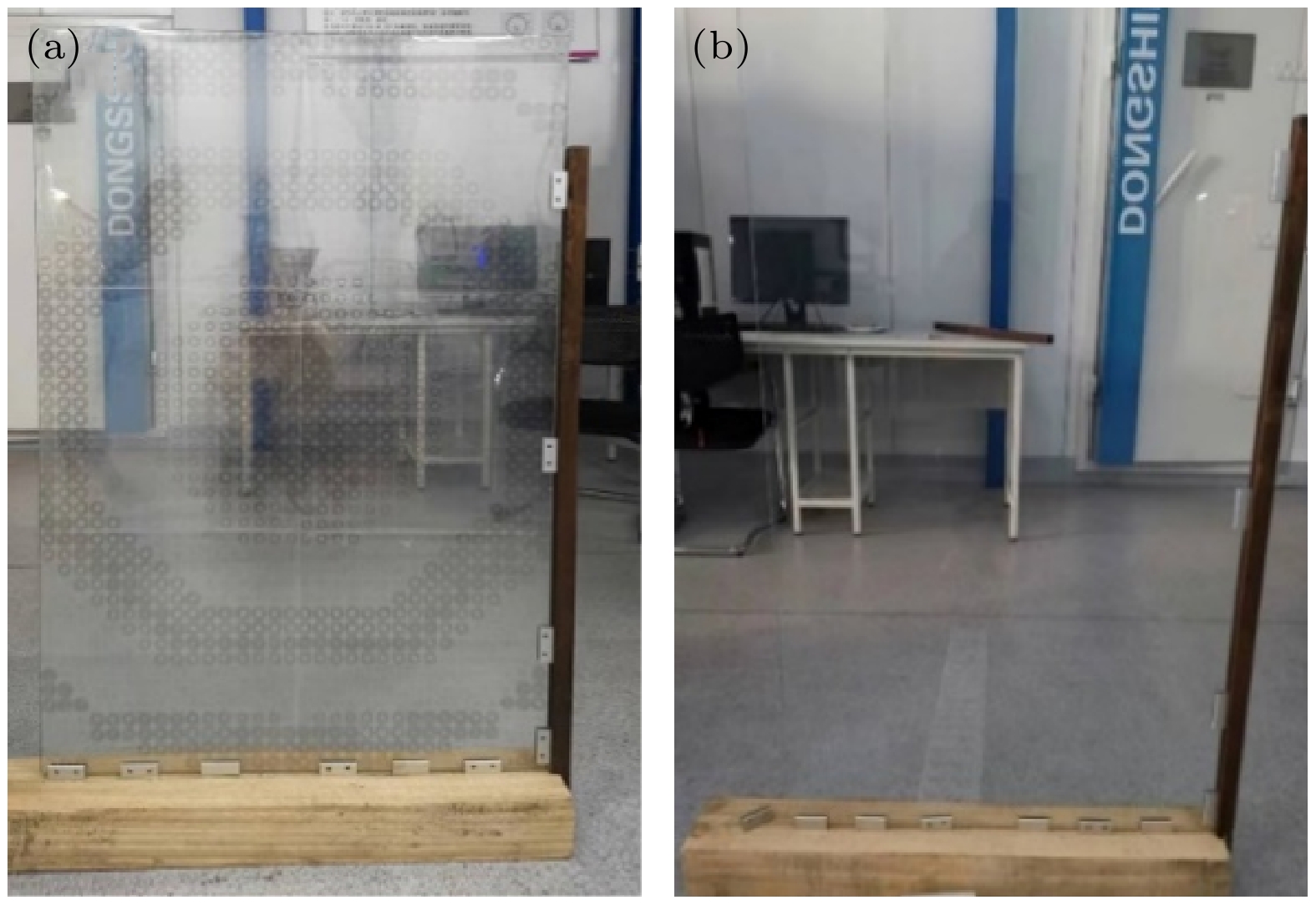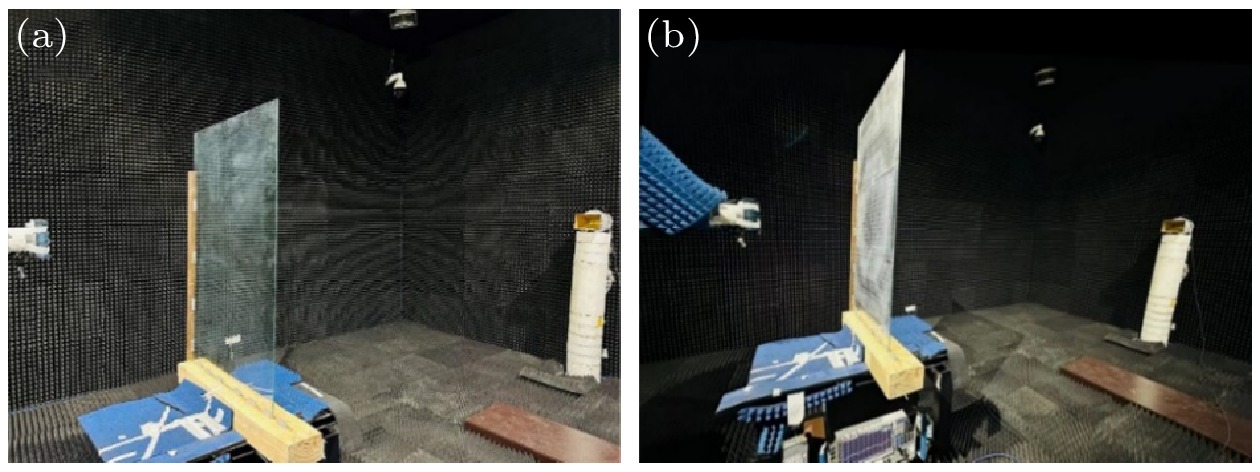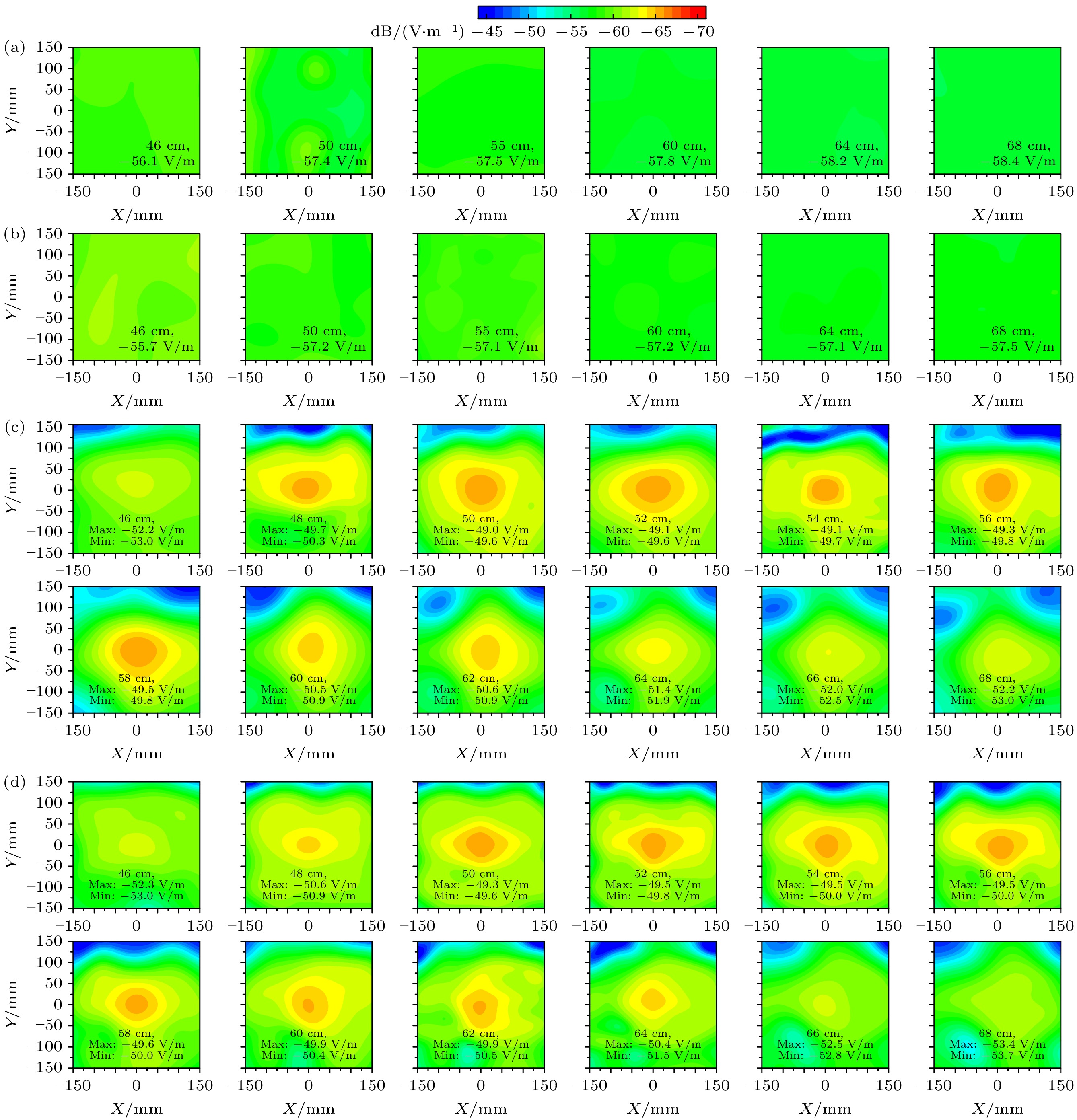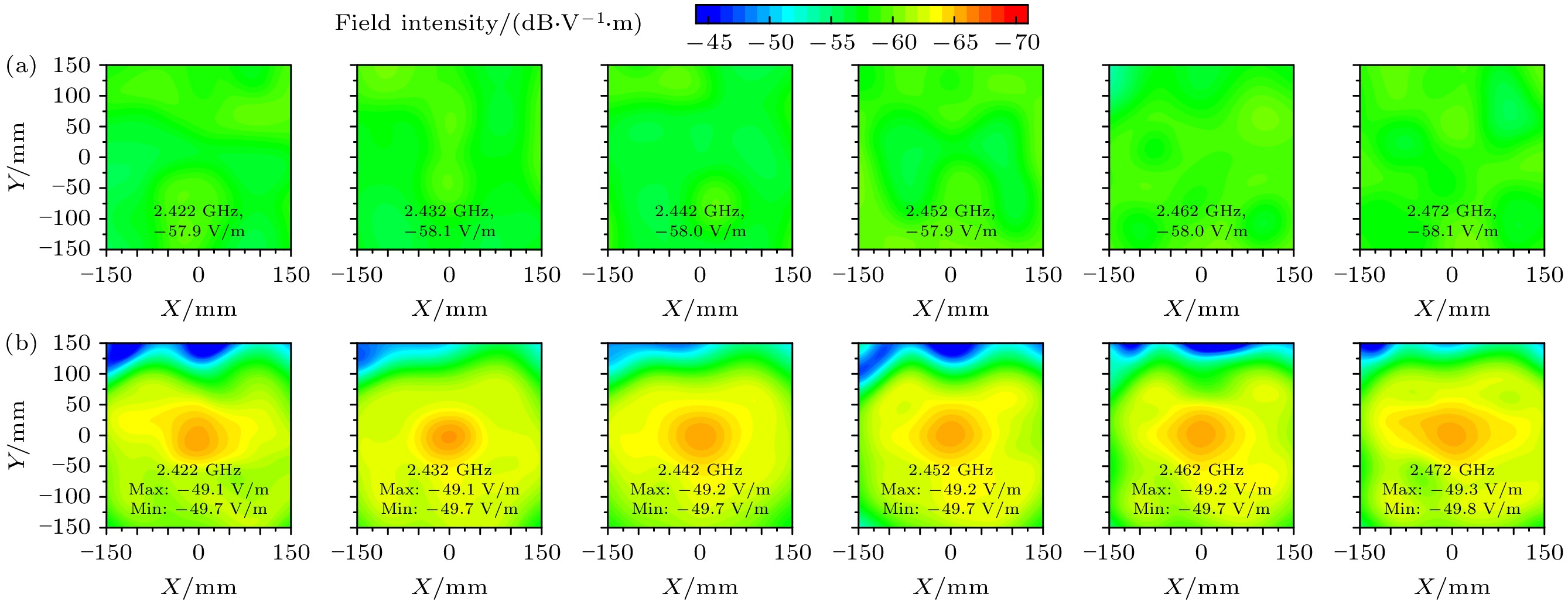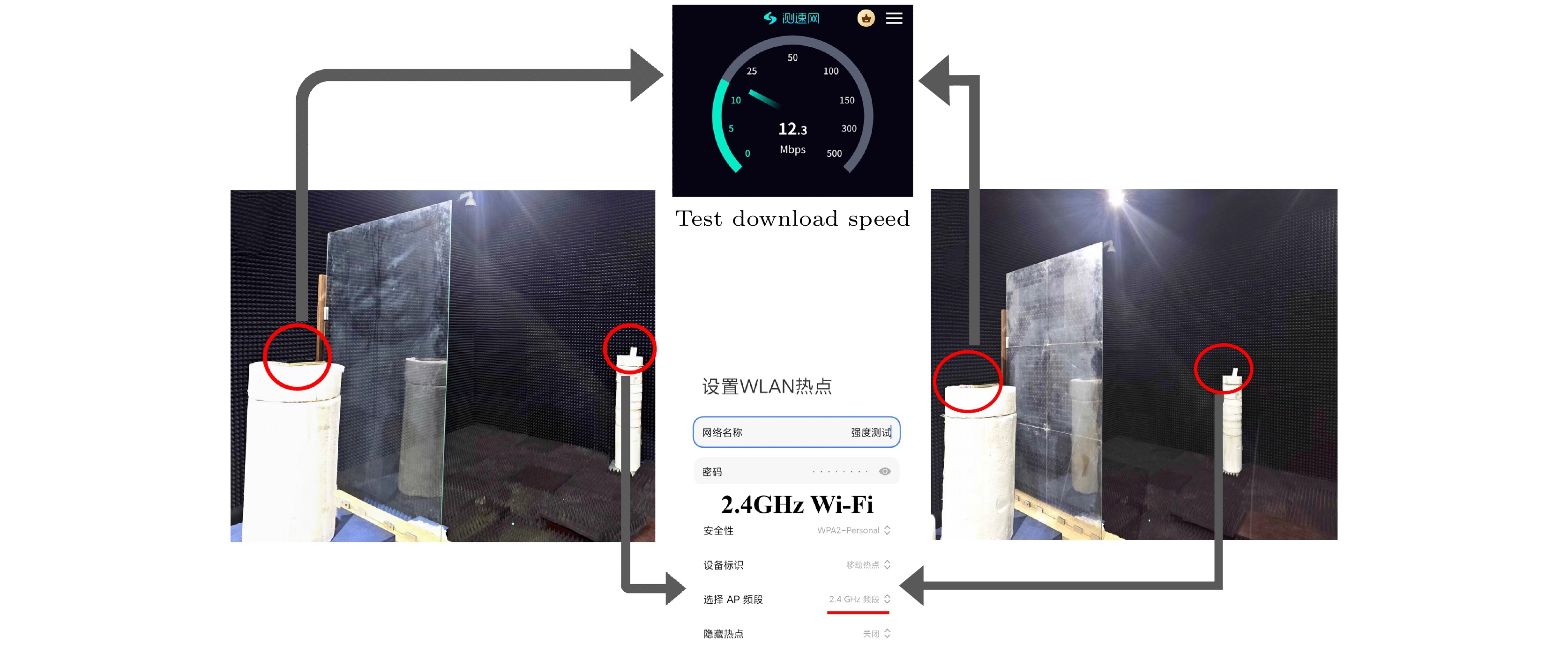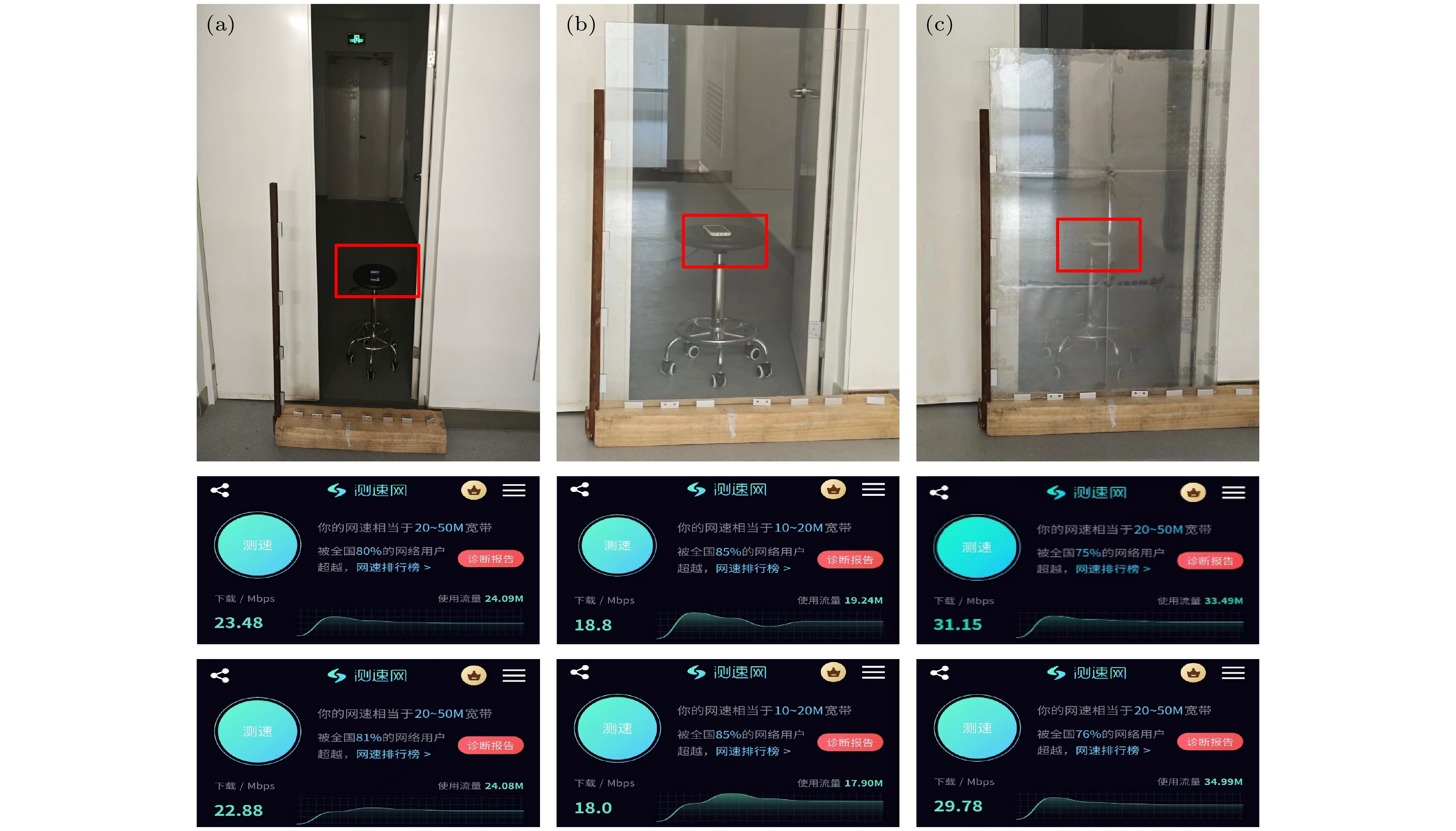-
玻璃作为目前室内常用的建筑材料, 无线信号通过玻璃时较大的插损会降低通信效率. 本文设计了一种工作在2.4 GHz Wi-Fi频段的光学透明超表面, 通过贴到玻璃两侧将无线信号实现区域聚焦以提高通信效率. 为了获得满足区域聚焦的相位设计, 超表面由耶路撒冷十字形和圆环两种双层结构组成, 透明导电薄膜采用导电性好、光学透明度高的铜网. 通过在微波暗室中扫描场强空间分布验证超表面的区域聚焦效果, 与空白玻璃对比, 在设计的整个聚焦区域均实现7.3 dB以上的场增强, 与仿真结果较为符合. 进一步测试了不同场景下的下载速度和网速稳定性验证透明超表面玻璃增强无线通信效率. 结果表明, 在实际使用环境中, 设计的超表面玻璃较空白玻璃的下载速度可提高10 Mb/s, 且下载速度浮动平稳. 本文设计的光学透明超表面结构简单, 使用便利, 同时具备可移动性, 可以根据通信增强需要进行随意摆放, 为室内通信增强提供了一种可行的技术途径.This paper presents the design of an optically transparent metasurface tailored for the 2.4 GHz Wi-Fi band. It is optically transparent and attaches to both sides of the glass to improve communication efficiency. The shape of focusing region is a rectangle with an area of 5 cm by 5 cm and a length of 10 cm. The metasurface attaches to both sides of the glass and realizes area focusing. To meet the requirements for area focusing, the metasurface possesses a double-layer structure of a Jerusalem cross and a circle, and the conductive thin film is a conductive and optically transparent copper mesh. The spatial distribution of field strength in a microwave unreflected chamber is scanned to verify the regional focusing effect of the metasurface. Compared with ordinary glass, the metalens achieves field enhancement of more than 7.3 dB in the designed aggregation region, with an average download speed increasing 20.2 Mb/s. Subsequently, the download speed and network speed stability in different scenarios are tested. The standard deviation is used to calculate the dispersion of the download speed. The results demonstrate that in the focusing area, comparing with ordinary glass, the average download speed of the signal across is increased by 13.8 Mb/s in the indoor environment, accompanied by a reduction in the standard deviation by 0.5. In the stairwell, the average download speed of the signal across of the metalens is observed to increase 12.1 Mb/s, accompanied by a reduction in the standard deviation by 1.4. In conclusion, the metasurface lens demonstrates the better ability to significantly reduce the standard deviation of download speed data in both indoor and stairwell test environments than in air and ordinary glass. This results in the effective smoothing out of the speed uctuations and the enhancing of signal transmission stability. Therefore, the ability of metalens to effectively reduce the amplitude of download speed fluctuations in various indoor environmental contexts confirms its key role in adapting to complex environments and improving the wireless communication performance. Moreover, the download speed of signals passing through the metalens is increased by more than 12 Mb/s in both test environmentsthan that of ordinary glass. This effectively improves not only the signal strength but also the communication efficiency. Concurrently, the designed optically transparent metasurface lens is straightforward in structure and user-friendly, and at the same time, it is moveable and can be positioned according to the needs of communication enhancement. The optically transparent metasurface lens scheme proposed in this study provides a potential solution to the high penetration loss problem currently encountered in indoor wireless communication.
-
Keywords:
- metasurface /
- optical transparency /
- Wi-Fi /
- signal enhancement
[1] Yang G, Du J F, Xiao M 2015 IEEE Trans. Commun. 63 3511
 Google Scholar
Google Scholar
[2] Mumtaz S, Rodriguez J, Dai L 2016 Mmwave Massive Mimo: A Paradigm for 5g (London: Academic Press
[3] Busari S A, Mumtaz S, Al-Rubaye S, Rodriguez J 2018 IEEE Commun. Mag. 56 137
 Google Scholar
Google Scholar
[4] Martinez-de-Rioja E, Vaquero A F, Arrebola M, Carrasco E, Encinar J A, Achour M 2021 Proceedings of the 15th European Conference on Antennas and Propagation (Eucap) Dusseldorf , Germany, Mar 22–26, 2021 p22
[5] Meng X D, Liu R X, Chu H C, Peng R W, Wang M, Hao Y, Lai Y 2022 Phys. Rev. Appl. 17 064027
 Google Scholar
Google Scholar
[6] Yu N F, Genevet P, Kats M A, Aieta F 2013 IEEE J. Sel. Topics Quantum Electron. 19 4700423
 Google Scholar
Google Scholar
[7] Aieta F, Genevet P, Yu N, Kats M A, Gaburro Z, Capasso F 2012 Nano Lett. 12 1702
 Google Scholar
Google Scholar
[8] Luo X 2015 Sci. China-Phys. Mech. Astron. 58 594201
 Google Scholar
Google Scholar
[9] Yu N F, Genevet P, Kats M A 2011 Science 334 6054
[10] Khorasaninejad M, Capasso F 2017 Science 358 6367
[11] Lalanne P, Chavel P 2017 Laser Photonics Rev. 11 1600295
 Google Scholar
Google Scholar
[12] Ming L T, Hsiao H H, Cheng H C, Mu K C, Sun G, Liu A Q, Tsai D P 2018 Adv. Opt. Mater. 6 1800554
 Google Scholar
Google Scholar
[13] Chen M K, Wu Y F, Feng L, Fan Q B, Lu M H, Xu T, Tsai D P 2021 Adv. Opt. Mater. 9 2001414
 Google Scholar
Google Scholar
[14] Banerji S, Meem M, Sensale-Rodriguez B, Majμmder A, Vasquez F G, Menon R 2019 Optica 6 805
 Google Scholar
Google Scholar
[15] Zou X J, Zheng G G, Yuan Q, Zang W, Zhu S 2020 Photoni X 1 2
[16] Chen W T, Zhu A Y, Capasso F 2020 Nat. Rev. Mater. 5 604
 Google Scholar
Google Scholar
[17] Wei Z Y, Cao Y, Su X P, Gong Z J, Li H Q 2013 Opt. Express 21 010739
 Google Scholar
Google Scholar
[18] Li H P, Wang G M, Liang J G, Gao X J, Hou H S, Jia X Y 2017 IEEE Trans. Antennas Propag. 65 11452
[19] 李雄, 马晓亮, 罗先刚 2017 光电工程 44 255
Li X, Ma X L, Luo X G 2017 Opto-Electron. Eng. 44 255
[20] 徐平, 李雄超, 肖钰斐, 杨拓, 张旭琳, 黄海漩, 王梦禹, 袁霞, 徐海东 2023 物理学报 72 014208
 Google Scholar
Google Scholar
Xu P, Li X C, Xiao Y F, Yang T, Zhang X L, Huang H X, Wang M Y, Yun X, Xu H D 2023 Acta Phys. Sin. 72 014208
 Google Scholar
Google Scholar
[21] Hong S, Kim Y, Oh J 2022 IEEE Trans. Antennas Propag. 70 6671
 Google Scholar
Google Scholar
[22] 孙彦彦, 韩璐, 史晓玉, 王兆娜, 刘大禾 2013 物理学报 62 104201
 Google Scholar
Google Scholar
Sun Y Y, Han L, Shi X Y, Wang Z N, Liu D H 2013 Acta Phys. Sin. 62 104201
 Google Scholar
Google Scholar
[23] Khorasaninejad M, Capasso F 2015 Nano Lett. 15 6709
 Google Scholar
Google Scholar
[24] Khorasaninejad M, Zhu A Y, Roques-Carmes C, Chen W T, Oh J, Mishra I, Devlin R C, Capasso F 2016 Nano Lett. 16 7229
 Google Scholar
Google Scholar
-
图 6 空白玻璃和超透镜的能流分布图 (a) 空白玻璃的正面能流分布; (b) 空白玻璃的侧面能流分布; (c) 超透镜的正面能流分布; (d) 超透镜的侧面能流分布
Fig. 6. Simulated energy distributions of the pure glass and the metalens: (a) Energy distributions on the front of the pure glass; (b) energy distribution on the side of the pure glass; (c) energy distributions on the front of the metalens; (d) energy distributions on side of the metalens.
图 10 超透镜信号增强实验测试 (a) 空白玻璃在2.412 GHz不同焦距处强度; (b) 空白玻璃在2.484 GHz不同焦距处强度; (c) 超透镜在2.412 GHz不同焦距处强度; (d) 超透镜在2.484 GHz不同焦距处强度
Fig. 10. Experimental test field-intensity enhancement of the metalens: Intensity at different focal lengths of 2.412 GHz (a) and 2.484 GHz (b) of the pure glass; intensity at different focal lengths of 2.412 GHz (c) and 2.484 GHz (d) of the metalens.
表 1 信号穿过空白玻璃和超透镜对应的下载速度
Table 1. Comparing the download speeds of signals traversing the pure glass and the metalens.
距离/cm 50 55 60 68 穿过玻璃的下载速度/(Mb·s–1) 31.15 30.88 30.28 29.42 穿过超透镜的下载速度/(Mb·s–1) 51.90 50.89 49.98 32.56 -
[1] Yang G, Du J F, Xiao M 2015 IEEE Trans. Commun. 63 3511
 Google Scholar
Google Scholar
[2] Mumtaz S, Rodriguez J, Dai L 2016 Mmwave Massive Mimo: A Paradigm for 5g (London: Academic Press
[3] Busari S A, Mumtaz S, Al-Rubaye S, Rodriguez J 2018 IEEE Commun. Mag. 56 137
 Google Scholar
Google Scholar
[4] Martinez-de-Rioja E, Vaquero A F, Arrebola M, Carrasco E, Encinar J A, Achour M 2021 Proceedings of the 15th European Conference on Antennas and Propagation (Eucap) Dusseldorf , Germany, Mar 22–26, 2021 p22
[5] Meng X D, Liu R X, Chu H C, Peng R W, Wang M, Hao Y, Lai Y 2022 Phys. Rev. Appl. 17 064027
 Google Scholar
Google Scholar
[6] Yu N F, Genevet P, Kats M A, Aieta F 2013 IEEE J. Sel. Topics Quantum Electron. 19 4700423
 Google Scholar
Google Scholar
[7] Aieta F, Genevet P, Yu N, Kats M A, Gaburro Z, Capasso F 2012 Nano Lett. 12 1702
 Google Scholar
Google Scholar
[8] Luo X 2015 Sci. China-Phys. Mech. Astron. 58 594201
 Google Scholar
Google Scholar
[9] Yu N F, Genevet P, Kats M A 2011 Science 334 6054
[10] Khorasaninejad M, Capasso F 2017 Science 358 6367
[11] Lalanne P, Chavel P 2017 Laser Photonics Rev. 11 1600295
 Google Scholar
Google Scholar
[12] Ming L T, Hsiao H H, Cheng H C, Mu K C, Sun G, Liu A Q, Tsai D P 2018 Adv. Opt. Mater. 6 1800554
 Google Scholar
Google Scholar
[13] Chen M K, Wu Y F, Feng L, Fan Q B, Lu M H, Xu T, Tsai D P 2021 Adv. Opt. Mater. 9 2001414
 Google Scholar
Google Scholar
[14] Banerji S, Meem M, Sensale-Rodriguez B, Majμmder A, Vasquez F G, Menon R 2019 Optica 6 805
 Google Scholar
Google Scholar
[15] Zou X J, Zheng G G, Yuan Q, Zang W, Zhu S 2020 Photoni X 1 2
[16] Chen W T, Zhu A Y, Capasso F 2020 Nat. Rev. Mater. 5 604
 Google Scholar
Google Scholar
[17] Wei Z Y, Cao Y, Su X P, Gong Z J, Li H Q 2013 Opt. Express 21 010739
 Google Scholar
Google Scholar
[18] Li H P, Wang G M, Liang J G, Gao X J, Hou H S, Jia X Y 2017 IEEE Trans. Antennas Propag. 65 11452
[19] 李雄, 马晓亮, 罗先刚 2017 光电工程 44 255
Li X, Ma X L, Luo X G 2017 Opto-Electron. Eng. 44 255
[20] 徐平, 李雄超, 肖钰斐, 杨拓, 张旭琳, 黄海漩, 王梦禹, 袁霞, 徐海东 2023 物理学报 72 014208
 Google Scholar
Google Scholar
Xu P, Li X C, Xiao Y F, Yang T, Zhang X L, Huang H X, Wang M Y, Yun X, Xu H D 2023 Acta Phys. Sin. 72 014208
 Google Scholar
Google Scholar
[21] Hong S, Kim Y, Oh J 2022 IEEE Trans. Antennas Propag. 70 6671
 Google Scholar
Google Scholar
[22] 孙彦彦, 韩璐, 史晓玉, 王兆娜, 刘大禾 2013 物理学报 62 104201
 Google Scholar
Google Scholar
Sun Y Y, Han L, Shi X Y, Wang Z N, Liu D H 2013 Acta Phys. Sin. 62 104201
 Google Scholar
Google Scholar
[23] Khorasaninejad M, Capasso F 2015 Nano Lett. 15 6709
 Google Scholar
Google Scholar
[24] Khorasaninejad M, Zhu A Y, Roques-Carmes C, Chen W T, Oh J, Mishra I, Devlin R C, Capasso F 2016 Nano Lett. 16 7229
 Google Scholar
Google Scholar
计量
- 文章访问数: 5125
- PDF下载量: 123
- 被引次数: 0














 下载:
下载:
